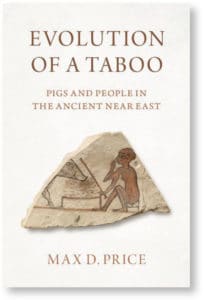May 11, 2022 0 Comments 704 views
Evolution of a Taboo: Pigs and People in the Ancient Near East
By Max D. Price
(Oxford: Oxford Univ. Press, 2020), xxii + 312 pp., 19 figures
(maps, graphs, plans, drawings, photos), $34.95 (hardcover)
Reviewed by Aren M. Maeir
As someone who has been studying the Philistine culture for some 25 years, I am greatly interested in the dietary patterns of the Iron Age Philistines and their neighbors—including who did and who didn’t eat pig. And this is one of the central issues addressed in the recent book by Max Price. An anthropologist and zoologist at MIT, Price explores the complex relations between pigs and humans in the Near East, focusing on ancient times but also providing perspective on the deep cultural ramifications until today.
Price first provides the geographical, zoological, and cultural background and tells the early history of human-pig interaction. He then delves into the archaeology of the late prehistoric period, Bronze Age, and Iron Age, covering the complex process of pig domestication, the role of the pig in early cities, the theoretical issues of the pig taboo, and the appearance of the taboo in early Israel. On the extensively discussed topic of pork consumption among the Philistines and the lack thereof in Israel and Judah, he stresses that simplistic interpretations (pig = Philistine, no pig = Israelite/Judahite) are in need of revision, because the evidence shows a more complex picture. He nevertheless believes that there is a clear dichotomy in the early Iron Age between pig-eating Philistines and abstaining Israelites/Judahites, even as he assumes that the biblical prohibitions date to the late Iron Age, when the biblical writers used the earlier Israelite abstention from pig as a way to define their culture as unique.
The book also discusses the importance of pigs in the Greco-Roman diet and of pig avoidance in the identification, definition, and construction of Jewish “otherness.” The consumption of pig became a central factor in the meeting between Judaism and the classical and then later Christian world. Finally, Price discusses the pig taboo in early Islam and how it became a central identifying factor between Muslims and Christians, from the early Middle Ages until today.
Become a Member of Biblical Archaeology Society Now and Get More Than Half Off the Regular Price of the All-Access Pass!
Explore the world’s most intriguing Biblical scholarship
Dig into more than 9,000 articles in the Biblical Archaeology Society’s vast library plus much more with an All-Access pass.
This is an excellent book on a very complex topic. It is well structured and easy to read. Let me offer just a few critical comments.
As someone who “digs” the Philistines, I have several comments regarding pigs and Philistines. For one, it is incorrect to state that in the regions from which the Philistines derived (e.g., the Aegean), pig eating was common. Rather, the origins of the Philistines are diverse (not only the Aegean),a and, even within the Aegean, the consumption of pig was hardly consistent. It also seems to me that although Price is aware of the complexity of assigning archaeological remains to specific identities, he often makes somewhat simplistic connections between material culture and very specific identity groups. I would advise a more prudent approach.1
Price dates the textual codification of the Israelite/Judahite pig taboo to the eighth or seventh century in Judah, based on a late Iron Age dating for the Deuteronomist and Priestly sources in the Bible.b However, since the dating of these sources is highly debated, it is somewhat precarious to use it as a central argument in the formation of the taboo. Price also repeatedly refers to an early halakhah (Jewish ritual law) in the Iron Age. Although there undoubtedly were ritual customs from the Iron Age Judahites/Israelites that were passed on to later Jewish communities, the major differences between ritual practices in the Iron Age and post-Iron Age communities suggest that one cannot assume the existence of a halakhah in Iron Age Judah. It has recently been shown, for instance, that the biblical prohibitions regarding fish were not adhered to in Iron Age Jerusalem, and evidence of pork consumption was found in late Iron Age Jerusalem.2
My present quibbles are not meant to obscure the fact that this is an excellent book, one that both summarizes a large amount of information on such a complex and interesting topic and offers an overall picture of the development of the pig taboo—in Judaism and later in Islam. It also shows how the taboo defined different ethnic and religious groups and what role it played in their interactions with neighboring groups and cultures. Although I do not agree with the author’s every statement, this book will certainly establish itself as the basic text on this important topic for many years to come.
Aren M. Maeir is Professor of Archaeology at Bar-Ilan University in Israel. He directs the Tell es-Safi/Gath Archaeological Project, which is processing and publishing its discoveries.
Notes:
1. Aren M. Maeir, “On Defining Israel: Or, Let’s Do the Kulturkreislehre Again!” Hebrew Bible and Ancient Israel 10.2 (2021), pp. 106–148.
2. Yonatan Adler and Omri Lernau, “The Pentateuchal Dietary Proscription Against Finless and Scaleless Aquatic Species in Light of Ancient Fish Remains,” Tel Aviv 48.1 (2021), pp. 5–26; Lidar Sapir-Hen, Joe Uziel, and Ortal Chalaf, “Everything but the Oink: On the Discovery of an Articulated Pig in Iron Age Jerusalem and Its Meaning to Judahite Consumption Practices,” Near Eastern Archaeology 84.2 (2021), pp. 110–119.
a. For more on Philistine origins, see p. 30.
b. See Richard Elliott Friedman, “Taking the Biblical Text Apart,” Bible Review, Fall 2005.



